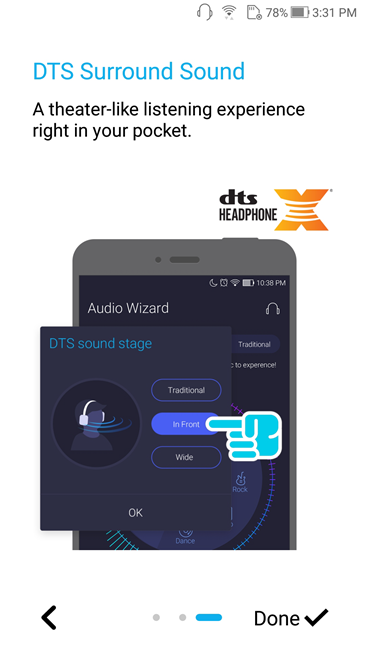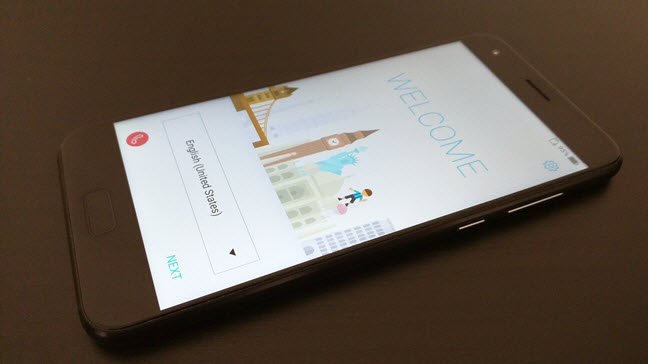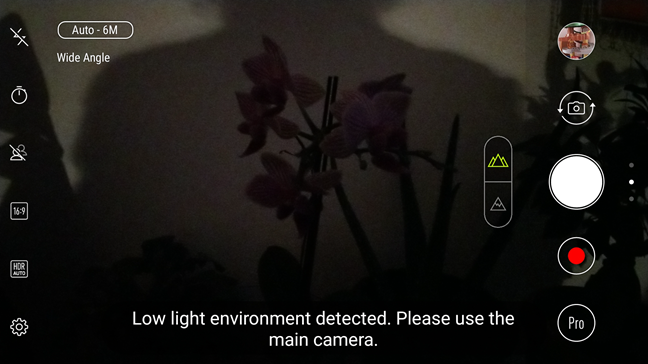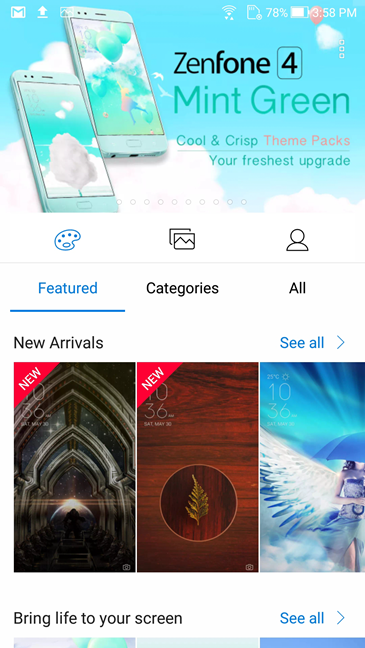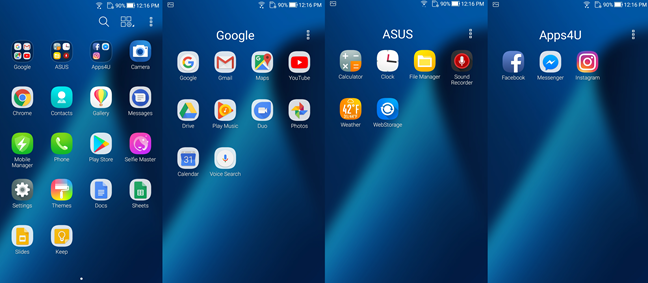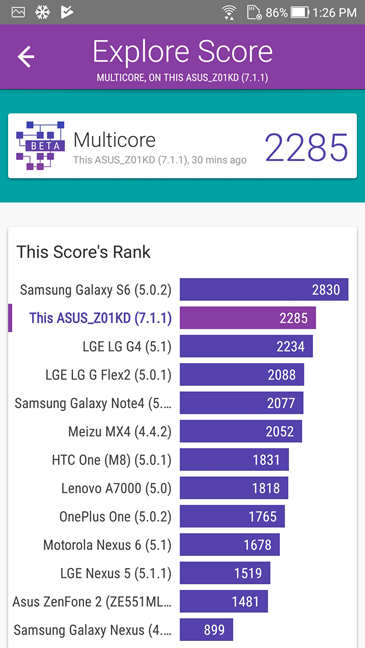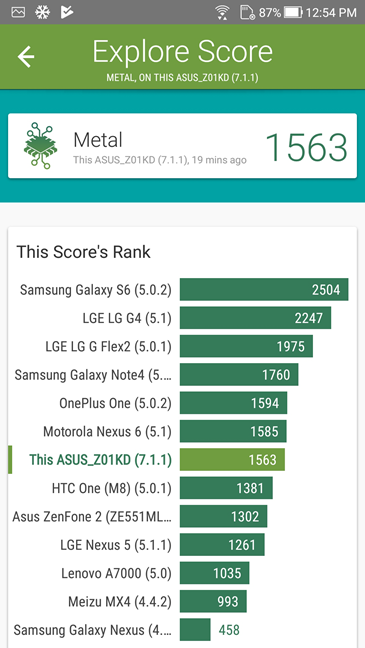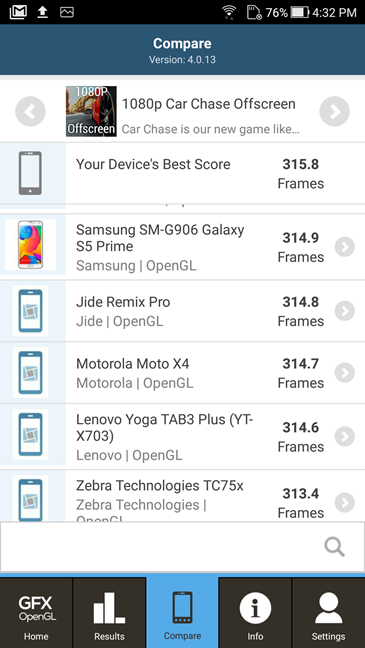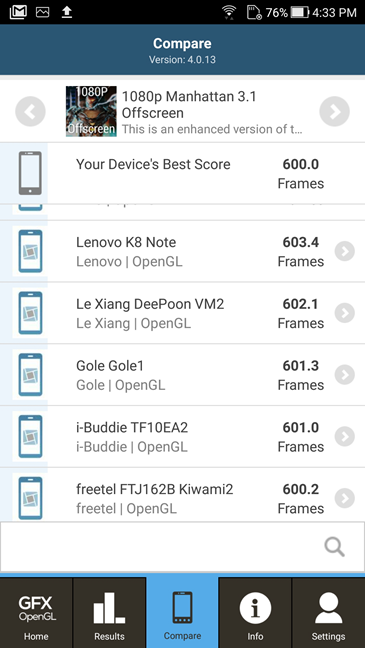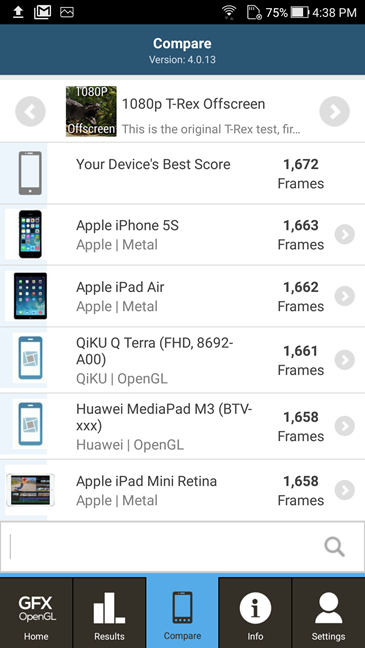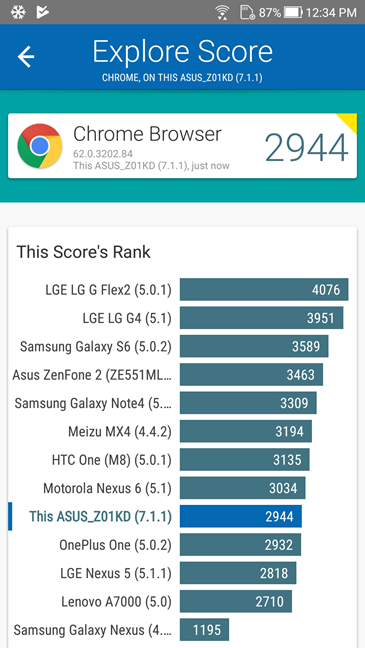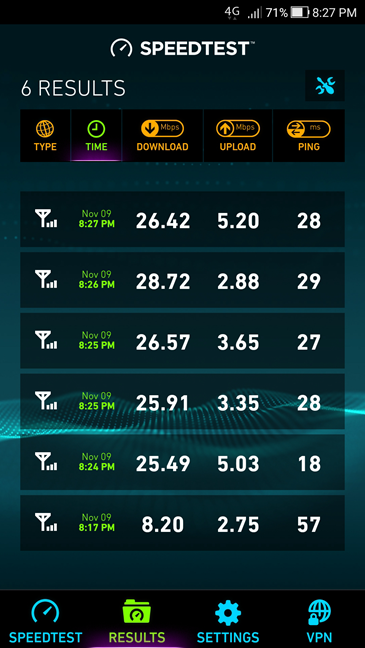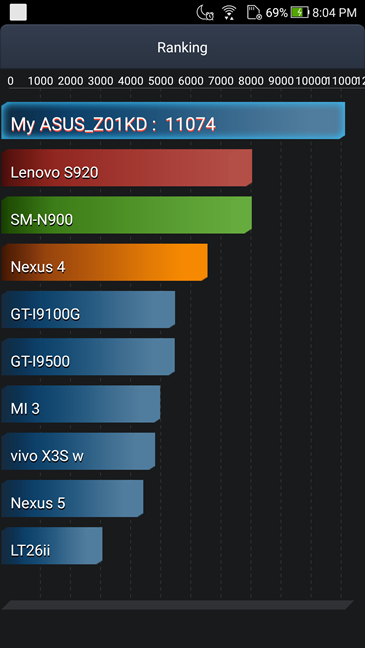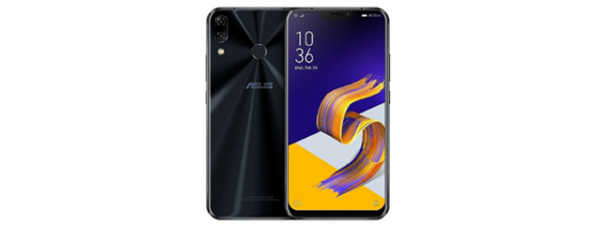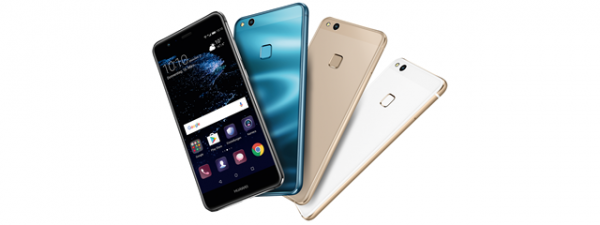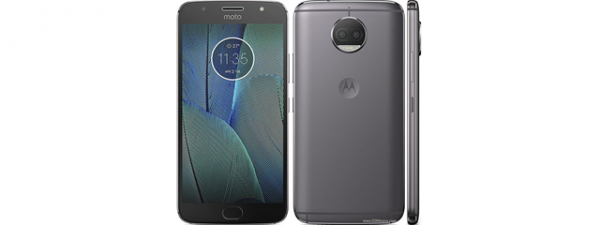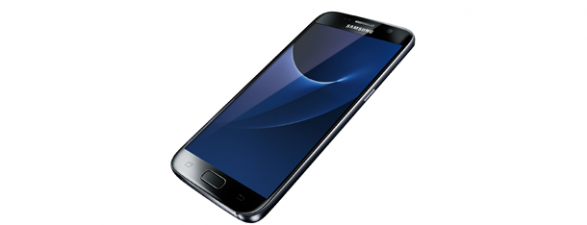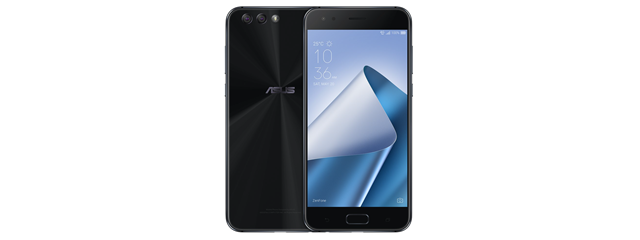
The smartphone experience on the ASUS ZenFone 4
The ASUS ZenFone 4 performs admirably when it comes to phone calls. The sound in conversations is crisp and has a high level of clarity, both when connected to 4G networks and when connected to 2G or 3G. We did not have issues in understanding the people we were talking with and they had no problem understanding us. Also, the signal reception is good: we did not see the phone lose connection during the time we had it in testing, even though we are in a mountainous region with not so great mobile coverage.
The ASUS ZenFone 4 is a good device for watching movies or listening to music. The loudspeaker is not powerful but the sound you get from it is clear and there are no distortions even at maximum volume. The audio experience is, of course, at another level if you connect and use a pair of headphones. The ones that are bundled with the smartphone are of good quality too. Also, when you use headphones, the ASUS ZenFone 4 can be configured to use DTS (Digital Theater System), a technology that transforms the sound into a surround system experience. It is especially nice to use when watching movies on your smartphone.
The display found on the ASUS ZenFone 4 is bright and its colors are vivid and punchy. We did not have any issues in understanding what was displayed on it even when we used the smartphone outdoors, in sunlight. The resolution and the size of the display are also well balanced, and the 410 ppi is a high value, enough to make fonts and lines look smooth and beautiful.
The octa-core processor and the 4 gigabytes of RAM are more than enough to give the operating system and the apps you use the power they need. Everything runs fine and opens fast on the ASUS ZenFone 4, and multitasking is easy on it. It is also a good smartphone for gaming, if you want some entertainment. The graphics chip is strong enough to give you good framerates at normal or even high quality settings, in all the games that you play.
The ASUS ZenFone 4 smartphone draws its autonomy from a non-removable 3300 mAh battery which is enough to get you through a whole day of use. If you use the smartphone lightly, you might even get to a day and a half between charges. If you use it extensively though, you might have to charge the ASUS ZenFone 4 twice a day. Gaming usually leads to this issue of twice-a-day charging.
Using the ASUS ZenFone 4 smartphone is a pleasant experience. Phone calls are of good quality, the operating system and the apps are snappy, multitasking is fast, and gaming is satisfying. Overall, we believe you will like this smartphone in daily use.
The camera experience on the ASUS ZenFone 4
A thing that sets the ASUS ZenFone 4 apart from many other mid-range smartphones, is the fact that it has a set of dual cameras on its back. The primary camera of the two has 12 megapixels, while the secondary camera has 8 megapixels. The smartphone uses a Sony IMX362 image sensor and the first camera has an aperture of f/1.8, 6-element lens, a field of view of 83 degrees, PDAF (Phase Detection Auto Focus), 4-axis optical image stabilization, and an LED flash. The secondary rear camera has a wider field of view, of 120 degrees, and can be useful for when you want to shoot large groups of people, for instance.
We generally liked how the main cameras take photos. The smartphone is fast when focusing and shooting photos. The results you get are generally of good quality. Photos have nice colors, good brightness, and contrast, and are not oversaturated or noisy. The only small complaint we have is the same as for most smartphones: the ASUS ZenFone 4 is not that great when the surrounding environment has low light. In dim light, like during the night, the main camera sometimes focuses wrongly, and the photos it takes can be excessively noisy. Also, the secondary main camera, the wide-angle one, is not usable in low light. If you want to use it in dim light, the smartphone tells you to switch to the main camera.
However, overall, the photos you take with the ASUS ZenFone 4 are pretty good, and are generally better than those we shot with the Motorola Moto Z2 Play for instance, which is a smartphone with a similar price tag.
The front camera has 8 megapixels, an aperture of f/2.0 and a field of view of 84 degrees. It shoots good selfies if the light is good and it does a great job if you like beautification effects.
In the gallery below you can see a couple of pictures that we have taken with the ASUS ZenFone 4. There are photos shot outdoors as well as indoors; photos taken in natural light and photos taken in the dark, a few selfies and also some close-ups.
The smartphone can record videos in 4K, at a maximum resolution of 3840 by 2160 pixels and 30 fps. It also offers 3-axis electronic image stabilization. If you want to see how good the ASUS ZenFone 4 is at recording videos with movement, here is a sample:
We also used the ASUS ZenFone 4 to record a panorama. This video gives you an idea of how good it is at recording static videos, with little or no movement involved.
The ASUS ZenFone 4 shoots beautiful photos when there is enough light around you. The photos have nice colors and good contrast. They do not feel like they are over processed. The secondary dual camera is good for capturing wide photos like when you want to take a picture of everyone at the table, for example. ASUS ZenFone 4 only has problems when it comes to taking photos in low light, that suffer from excessive noise. But, the smartphone also does a good job when it comes to recording videos, and the electronic stabilization engine helps with keeping the image steady. Overall, the photo and video performance you get from the ASUS ZenFone 4 is good, above the average you get with mid-range smartphones.
Android 7 Nougat, ASUS ZenUI and bundled apps
The operating system running on the ASUS ZenFone 4 is Android 7.1.1 Nougat. On top of the default user interface offered by Android, ASUS added their own ASUS ZenUI user interface, which now has reached version number 4. The user interface looks good and the main changes it adds to the default Android experience are related to the way settings are organized and to the additional customization options you get. The best thing about it is the theming system which allows you to change the way your interface looks, wallpapers, fonts, icons and others, with just a few taps. Most themes are free but some of them are also paid.
One thing that impressed us about the ASUS ZenFone 4 is the fact that this looks like it is the first ASUS smartphone that does not bundle a lot of bloatware, and this is a great positive. Here is the list of apps that come preinstalled on the ASUS ZenFone 4, besides the default Android ones:
-
File Manager - an app which you can use to see and manage the files found on your ASUS ZenFone 4. Everybody has to have a file manager on their smartphone, so this is a good a choice as any other.
-
Gallery - an app that lets you browse and open the photos and videos you take with your ASUS ZenFone 4. We prefer Google Photos.
-
Instagram - the mobile app of the popular photo-sharing, video-sharing and social networking service.
-
Messenger - the mobile app from Facebook that allows you to connect and talk with your Facebook friends.
-
Mobile Manager - an app that acts as a central point for various system maintenance tasks. It gives you a quick overview of your battery and memory use, as well as quick access to the power saver battery modes, to the details of your data usage, the apps that are allowed to show push notifications and so on.
-
Selfie Master - lets you shoot selfie photos and add beautification effects over them, as well as create collages or slideshows using your photos.
-
Sound Recorder - a simple app that uses the smartphone's microphone to record sound.
-
Themes - a portal where you can see, download, install and apply various system themes for the ZenUI user interface. As we already said earlier, we really like these themes and, from a beautification perspective, they are totally worth it.
-
Weather - an app that shows you weather forecasts.
-
WebStorage - is a cloud service from ASUS that offers you 5GB of free storage space.
The ASUS ZenFone 4 comes with Android 7 Nougat and ASUS ZenUI 4. The user interface looks good and the customization options you get from ZenUI 4 are useful. We especially appreciate the fact that ASUS has finally decided to stop preloading so much bloatware on their smartphones. There are few bundled apps on the ZenFone 4, and some of them are truly useful for their users.
Performance in benchmarks
Are hardware specifications and personal impressions enough to get an idea of how fast a device is at doing its job? Most probably not and that's why it is always better to also have some objective speed measurements. Here are the results we got when running benchmarks on the ASUS ZenFone 4:
The first thing we tested was the performance of the 2.2 GHz octa-core processor found inside this smartphone. To do that, we ran a few tests with a benchmarking app called Vellamo.
The first test we ran is Vellamo Multicore, which measures the speed of the processor when running multiple tasks simultaneously. The ASUS ZenFone 4 obtained 2285 points, a score that is, unfortunately, not that impressive. It is slightly less than the score of its predecessor, the ASUS ZenFone 3, and less than the score of a more affordable Huawei P10 lite for example. However, it is also a bit higher than what you get from a Motorola Moto Z2 Play for instance.
The next benchmark tests we ran are also designed to assess the processor's performance, but this time they measure its speed in single tasks, when only one core is used. The ASUS ZenFone 4 obtained 1563 points. Once more, it is not an impressive result, but is a good score anyway. It is an almost identical score to that of its older brother, the ASUS ZenFone 3. The Motorola Moto Z2 Play and the more affordable Huawei P10 lite also get similar scores in this benchmark.
Next came the gaming benchmarks and for them we used an app that is named GFXBench GL Benchmark. We recorded the results measured in the 1080p Car Chase Offscreen, 1080p Manhattan 3.1 Offscreen and 1080p T-Rex Offscreen tests. We only use the standardized 1080p tests because the resolution is always 1080p and it gives us results that we can compare with those from other smartphones, even if their native screen resolutions differ.
ASUS ZenFone 4 rendered 315.8 frames in the 1080p Car Chase Offscreen test. It is a better score than that we have seen on the ASUS ZenFone 3, Motorola Moto Z2 Play or Huawei P10 lite. It also shows that the ASUS ZenFone 4 is a good smartphone if you want to play new games on it.
In the 1080p Manhattan 3.1 Offscreen test, the ASUS ZenFone 4 rendered 600 frames, which is a much better result than that of a Motorola Moto Z2 Play or an ASUS ZenFone 3. It is also more than double what you get on a Huawei P10 lite.
The third and final gaming test we ran was 1080p T-Rex Offscreen, a test which shows you how the smartphone fares in older games with fewer visual details. ASUS ZenFone 4 rendered 1672 frames, which is more than what you get from the ASUS ZenFone 3 and Motorola Moto Z2 Play, and double what you get from a Huawei P10 lite.
Now we have an idea about the performance in games offered by the ASUS ZenFone 4. Now let's see what we should expect in terms of performance in a more common activity: web browsing. To get an idea on that, we turned back to Vellamo and ran its Browser tests. The ASUS ZenFone 4 got a score of 2944 points. It is a good result, in line with that of the Motorola Moto Z2 Play and Huawei P10 lite but, oddly, it is less than what we got on the ASUS ZenFone 3.
The ASUS ZenFone 4 can connect and use 4G networks, so we wanted to test its speed in and reliability in this matter too. To measure data transfer speeds, we used Speedtest. The results we got were not impressive, but they could not be, as our mobile operator does not have a great coverage in our area and the data speed is not great. However, the data connections seem to be reliable and without drops.
Another important feature of any smartphone is how long it lasts on a full battery charge. To measure that, we usually run the "Work battery life" test from PCMark, which measures the autonomy of the battery when the device is running the normal day to day activities like browsing the web, working with documents, or editing photos. However, ASUS ZenFone 4 had troubles running this benchmark, so we had no choice but to use AnTuTu. Using its battery tests, the ASUS ZenFone 4 got a score of 11074 points, which is a good result. It shows that this smartphone can stay on for a day, on a charge, if you do not use it extensively.
The ASUS ZenFone 4 is a good mid-range smartphone: it can run any app fast and without lags, it can multitask, and it can run games at good quality settings and framerates above average.
What is your opinion about the ASUS ZenFone 4?
Now you know what our opinion is about the ASUS ZenFone 4. Also, you have seen its results in benchmarks and you know what it looks like. Before closing this review, share your opinion about this smartphone and whether you are interested in buying it or not. Comment below and let's discuss.




